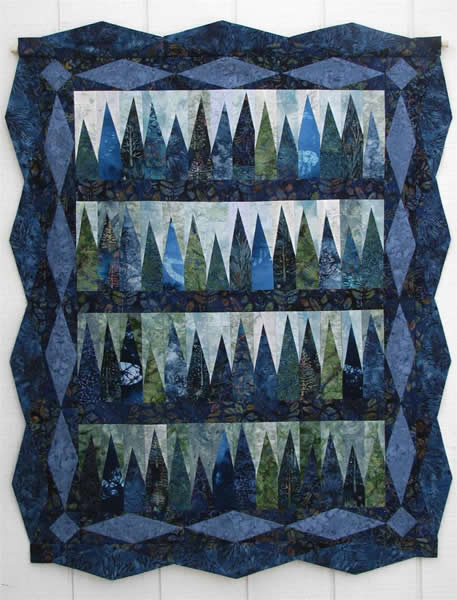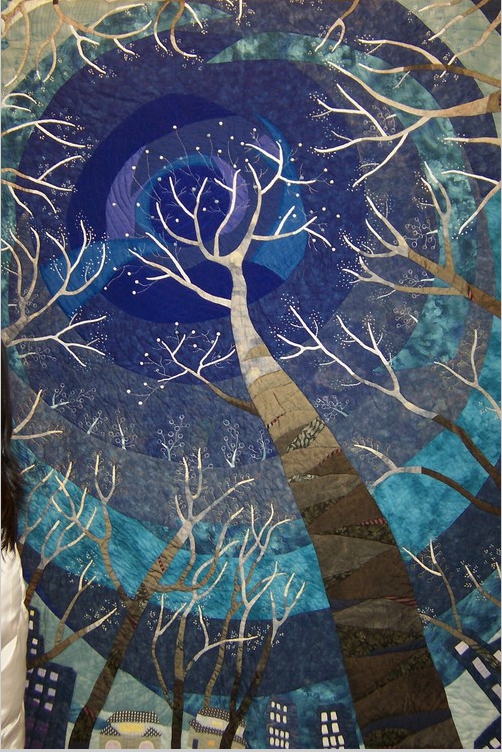Quilting Bee
By Effie Lee Newsome
Annotations by Karen Kilcup

Sometimes I play that in the spring The woods get scalloped scraps of green, And set the trees to gay quilting,[1] Making a merry, gorgeous scene, A sight I like to look up to— The sky helps piece the quilt with blue. Then there’s a change when autumn’s back, The green scraps turn to gold and red. The dark twigs stitch them still with black, But there’re more blue scraps overhead, And soon the whole quilt’s all blue-gray— The brighter scraps get blown away. And now I play each empty tree Is left there from the quilting bee. They can’t get home—so bent and old Out there with bare hands in the cold To wait for spring and gay green scraps To fill their old lean hands and laps.
Newsome, Effie Lee. “Quilting Bee.” Gladiola Garden: Poems of Outdoors and Indoors for Second Grade Readers. Washington, DC: Associated Publishers, 1940, 125.
[1] A quilting bee is a traditional community activity where a group of people gather to sew together squares (or other pieces) of fabric to form a quilt. The bee would also help sew together the top (pieced) section, a filling (such as a sheet of cotton batting), and a backing fabric. Newsome imagines the sky and trees as pieces in a quilt that her poem stitches together. Unlike a cloth quilt, nature’s “quilt” changes as the seasons change.
Contexts
Newsome worked among the many celebrated writers of the Harlem Renaissance, who included Langston Hughes, Countee Cullen, James Weldon Johnson, Zora Neale Hurston, and Anne Spencer, many of them poets. Among her noteworthy contributions to that movement was her writing and editing for W. E. B. Du Bois’s magazine, The Crisis, the official publication of the NAACP (National Association for the Advancement of Colored People). As John Claborn points out, Du Bois’s political goals embraced the idea of access to natural spaces, and the magazine featured environmental writing by such notable authors as Arna Bontemps, Claude McKay, and Hughes. Newsome contributed to and edited “The Little Page” (“Whimsies for the Younger Folk”), where much of her work emphasized nature. This poem, like many others in The Envious Lobster, uses the community activity of quilting to teach a natural history lesson.
Resources for Further Study
- Claborn, John. “The Crisis, the Politics of Nature, and the Harlem Renaissance: Effie Lee Newsome’s Eco-poetics.” Civil Rights and the Environment in African-American Literature, 1895-1941. New York: Bloomsbury Academic, 2017.
- “Effie Lee Newsome, 1885-1978.” Poets.org. This site provides access to seven of Newsome’s poems.
- Newsome, Effie Lee. Gladiola Garden: Poems of Outdoors and Indoors for Second Grade Readers. Courtesy of the New York Public Library, this site provides access to the entire text.
Contemporary Connections
Anonymous. Reading of Newsome’s poem, “The Bronze Legacy.” The illustrations for Gladiola Garden were done by prominent Black artist Loïs Mailou Jones (1905-1998).
Johnston, Amber O’Neal. “African American Poetry: Effie Lee Newsome. Heritage Mom blog.
One of the best-known quilting groups today is the community of Gee’s Bend, Alabama.
